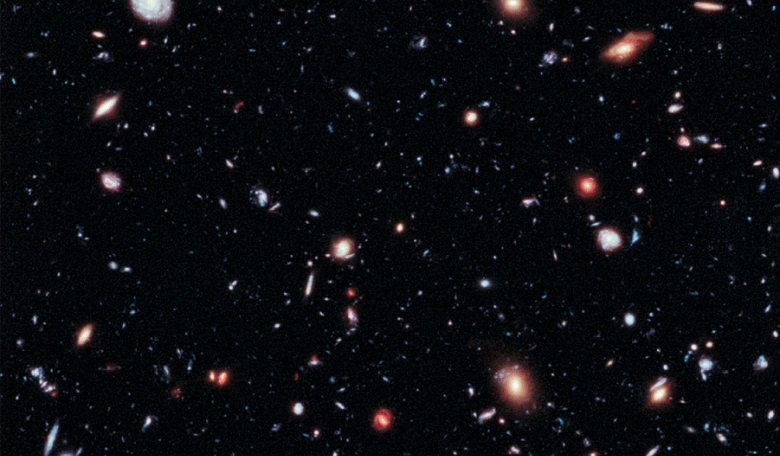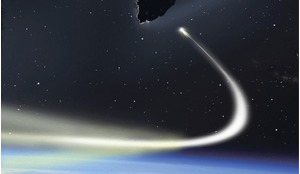The past few decades have seen remarkable advances in our knowledge of exoplanets (planets orbiting stars outside the solar system). The first, found in the 1990s, were extreme worlds known as hot Jupiters – gas giants with a mass and radius similar to Jupiter, but with much higher surface temperatures because they orbit very close to their host stars. Now, we’ve discovered thousands of exoplanets, many of which are much more like Earth in size and temperature. The latest experiments are now in the process of delivering hundreds of Earth-sized planets.
In the next few decades, we will witness significant advances in not just the detection of exoplanets, but also characterising their properties such as atmosphere, ocean and surface. This has the potential to be even more exciting; since we know life can have a large effect on a planet, this will allow us to determine whether life exists on exoplanets that we can characterise. So far, measurements have been mostly restricted to the atmosphere of about a dozen hot Jupiters. The next few decades will see multiple experiments that, when used in conjunction, will be capable of increasing this number a hundredfold, and allow us to probe Earth-like planets as well.
The goal of many of these upcoming experiments is stated as being “to maximise science return”, or in other words, maximising the total number of Earth-like planets that are characterised. With our current knowledge, having no information about the abundance or characteristics of life throughout the universe, it’s hard to come up with a better goal. However, it pays to draw an analogy with planet detection, because in many ways, the state of planet characterisation today mimics the state of planet detection in the 1990s.
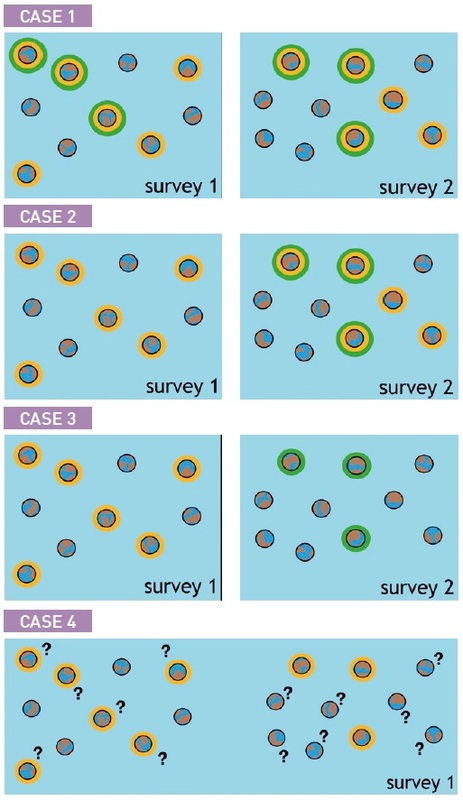 Figure 1. Representation of four different mission data-set scenarios. Each box represents the yield of a survey, and the cases determine how best to combine the results of different surveys. Cases 1-3 represent combining two different data sets that measure two biosignatures, denoted by orange and green halos. Case 1 is relevant for combining the LUVOIR and OWL-MOON missions, Case 2 corresponds to the RST and HabEx missions. In Case 3, relevant for JWST and SETI large scale technosignature searches, the survey sizes are balanced and provide complementary information. Case 4 represents the different types of uncertainties that will be present in measurements: question marks near haloed planets denote uncertainties in false positives, and question marks around unhaloed planets represent false negatives and false samples.
Figure 1. Representation of four different mission data-set scenarios. Each box represents the yield of a survey, and the cases determine how best to combine the results of different surveys. Cases 1-3 represent combining two different data sets that measure two biosignatures, denoted by orange and green halos. Case 1 is relevant for combining the LUVOIR and OWL-MOON missions, Case 2 corresponds to the RST and HabEx missions. In Case 3, relevant for JWST and SETI large scale technosignature searches, the survey sizes are balanced and provide complementary information. Case 4 represents the different types of uncertainties that will be present in measurements: question marks near haloed planets denote uncertainties in false positives, and question marks around unhaloed planets represent false negatives and false samples.
At that time, when detections were limited to extreme hot Jupiters, the goal was to find as many as possible to gain a robust understanding of when, where, and how often planets form. Now that we have detected thousands of exoplanets, we learn less from simply searching for more, and astronomers have shifted focus to observing interesting planetary systems that can be used to test hypotheses about planet formation, occurrence and composition.
A similar transition will eventually occur when it comes to characterising exoplanets as well, and so it should be helpful to anticipate how our goals will shift in advance. We can do this by defining the information gained from a given observation, which then allows us to assess the relative merits of upcoming missions, set guidelines to optimise their design, and prioritise which planets to point them at once they are operational.
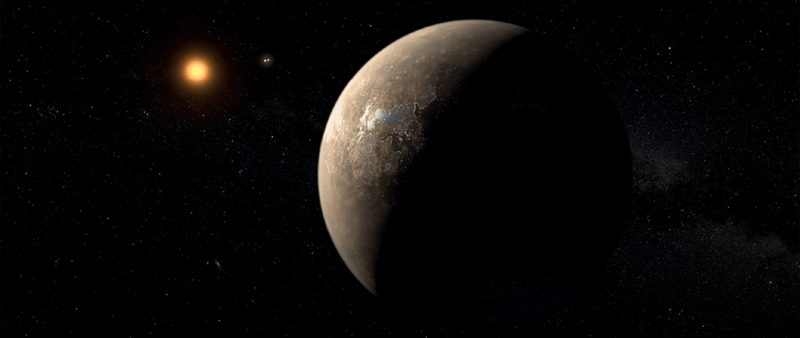 Proxima b shown orbiting Proxima Centauri, a red dwarf with a surface temperature of 3040 K, with the Alpha Centauri binary system shown in the background. Proxima b is the closest exoplanet to the Sun and also the closest potentially habitable exoplanet.
Proxima b shown orbiting Proxima Centauri, a red dwarf with a surface temperature of 3040 K, with the Alpha Centauri binary system shown in the background. Proxima b is the closest exoplanet to the Sun and also the closest potentially habitable exoplanet.
Types of Life
In the next few decades, we will witness significant advances in not just the detection of exoplanets, but also characterising their properties such as atmosphere, ocean and surface
First, let’s cover the types of things we may learn from characterising exoplanets. If we imagine Earth were a distant world, for example, we would be able to see many signs of life. Sensitive enough technology would detect our oxygen rich atmosphere, green continents, and perhaps even signs of technological civilisation like city lights and industrial pollutants. All of these are known as biosignatures – indications of some form of life.
From Earth’s example, it’s clear that not all biosignatures signal the same information. Certain signatures indicate the presence of life at different stages of evolution. We can classify the list of proposed biosignatures according to the type of life each indicates, according to the key innovations that occurred for life on Earth which we expect to be generic. Our candidate list is the origin of life, photosynthesis, multicellularity, and technological civilization.
 The ExoLife Finder (ELF) telescope from the PLANETS Foundation will be capable of viewing exoplanets 24 light years (120 trillion miles) away from Earth, detecting the energy signatures of life, and imaging oceans and continents. Its first target will be Proxima b, an exoplanet in the Proxima Centauri star system.
The ExoLife Finder (ELF) telescope from the PLANETS Foundation will be capable of viewing exoplanets 24 light years (120 trillion miles) away from Earth, detecting the energy signatures of life, and imaging oceans and continents. Its first target will be Proxima b, an exoplanet in the Proxima Centauri star system.
The first class of biosignature only tells us that microbial life is present, but nothing else about it. Generically, life will produce unstable molecules faster than they can disintegrate, as it rearranges molecular matter into useful organic molecules and gaseous by-products. Detecting methane, for example, on a planet where it is unstable, would be a fairly strong indicator of life. Several other molecules of this sort have been proposed as well, which may be easier or harder to detect and interpret, depending on the circumstances.
The second of these is photosynthesis. The development of the molecular technology to harness energy from the sun allowed for a millionfold increase in the energy available to organisms, and consequently increased the overall size of the Earth’s biosphere by this amount.
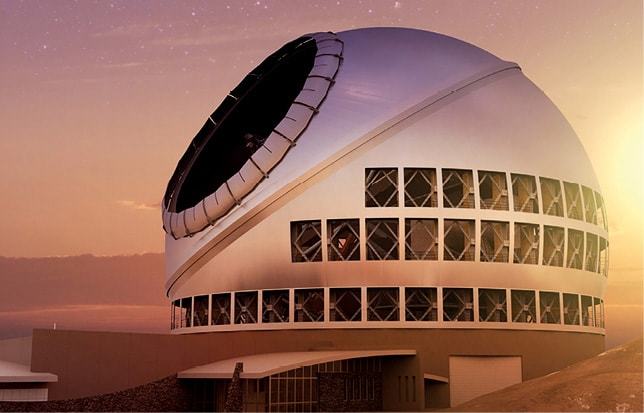 Artist’s illustration of the proposed Thirty Meter Telescope (TMT), part of a new class of extremely large telescopes. Developers say the telescope will provide unparalleled resolution, with images more than 12 times sharper than those from the Hubble Space Telescope. The siting of the telescope at Maunakea, Hawaii, has proved controversial and construction has been delayed by protestors.
Artist’s illustration of the proposed Thirty Meter Telescope (TMT), part of a new class of extremely large telescopes. Developers say the telescope will provide unparalleled resolution, with images more than 12 times sharper than those from the Hubble Space Telescope. The siting of the telescope at Maunakea, Hawaii, has proved controversial and construction has been delayed by protestors.
One way to detect photosynthesis is to look for atmospheric oxygen, which is a by-product of the process of ripping water molecules apart. We would have to ensure that there are no other major sources of oxygen to interpret a detection correctly, but this a highly promising avenue. Another method is to see if large patches of a planet collect light in the most energetically useful frequency bands – as is the case with Earth. Either of these would indicate not only that life is present, but that it has achieved a certain level of sophistication necessary to photosynthesise.
The third class of biosignatures looks for multicellularity, a feature that only evolved in earnest some 88 percent of the way through Earth’s history. This would be a bit more challenging, but is still potentially doable. The best bet for this would be to determine if a planet’s green colouring comes from land. Compared to the ocean, land is a dry, sun-baked, nutrient poor, harsh place, and an enterprising cell would require some sophisticated delivery architecture to obtain its water and necessary nutrients. Determining whether the green comes from land is not impossible, even if an exoplanet is less than a pixel wide; by seeing how its colours change as it rotates, we can gain sub-continental resolution of the relative fractions of water, desert, forest, and ice. If this can’t be done for a planet, other methods could be used, such as detecting smoke from forest fires.
Nobody knows what the first telescopes capable of detecting life on other planets are going to find
Lastly, we could search for technosignatures – indications that a large-scale industrial society is present on a planet. For this, we could search for city lights at night, industrial heat, or chemical by-products that are unlikely to occur organically. We can even search for civilizations that far exceed our current capabilities, whether they have produced the technology capable of harnessing all the energy from their planet, their host star, or beyond. It stands to reason that the more advanced a civilization is, the easier it will be to see, unless it is deliberately hiding.
Having outlined four separate classes of life to search for: simple life, photosynthesis, multicellularity, and technology, how do we prioritise between them, and what are the prospects for how well we will be able to measure them?
Information gain
The goal for future space missions should be to measure the occurrence rates of the four stages of life detailed above as accurately as possible. This can be mathematically defined in terms of the information content of our measurements according to the principles of information theory, the science originally developed to study communication channel carrying capacity. Maximising information roughly equates to minimising the product of the uncertainties of each measurement. If this metric is adopted, it can serve as a tool for evaluating and designing future missions. We are not proposing that information gain should be the only or final consideration when selecting between missions, but instead that it should be used as a rule of thumb that can yield general purpose lessons to be kept in mind when thinking about any future mission.
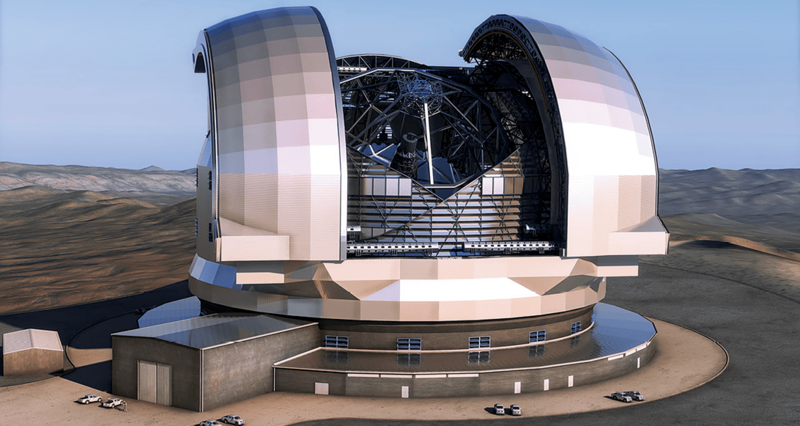 The European Southern Observatory is building the ELT (Extremely Large Telescope), a revolutionary new ground-based telescope which will have a 39-metre main mirror and will be the largest optical/near-infrared telescope in the world. First light is targeted for 2025.
The European Southern Observatory is building the ELT (Extremely Large Telescope), a revolutionary new ground-based telescope which will have a 39-metre main mirror and will be the largest optical/near-infrared telescope in the world. First light is targeted for 2025.
As an example, let’s restrict our attention to the measurement of a single type of biosignature; in this case, trying to determine its occurrence rate will have an inherent uncertainty due to the small number of planets we can sample. The larger the total number, the better the measurement, and the smaller the uncertainty. In this case, maximising the information gain recommends that we collect as many samples as possible within the allowed budget. Encouragingly, this is exactly the stated goal of many of the upcoming missions.
Measuring multiple biosignatures is more complex. Here, the most primitive biosignature (the presence of life) is limited by the number of planets in the sample, but the second (photosynthesis) is limited by the number of planets that have life, the uncertainty in the third measurement is limited by the number of the second, and so on. Unless the occurrence of each type of life is very common, the uncertainties will grow as we go down the list. If one of these stages turns out to be a rarely occurring ‘bottleneck’ (if developing photosynthesis was found to be extremely rare, for instance), then determining the occurrence rates for all steps beyond that are doomed to be highly uncertain. Consequently, in this scenario our guidelines dictate that most effort should be restricted to measuring biosignatures where we can get good statistics.
This approach is also useful for determining the best way to combine different data sets, a task which will be of prime importance since there will be many different missions in the coming years. As a simplest case, consider the scenario of two different missions which measure the same biosignatures.
This is relevant for combining the Large UV Optical Infrared Surveyor (LUVOIR) and OWL-MOON (OverWhelmingly Large-class lunar telescope) missions, described in more detail below. This scenario is shown in Figure 1 (see page 81) as Case 1, imagined as measuring two biosignatures, denoted by orange and green halos. Here the measurement uncertainties depend on the sum of the two mission yields. Minimising this is achieved when the overall number is maximised; in this case, we should spend more money on the mission that can be scaled up the most within the given budget.
It stands to reason that the more advanced a civilisation is, the easier it will be to see, unless it is deliberately hiding
A slightly more complicated scenario (Case 2) combines data from two missions, where one only measures the more primitive biosignature, and the other measures two. This may correspond to the Roman Space Telescope (RST) and Habitable Exoplanet Imaging (HabEx) missions, for example. In this case, the uncertainty of the more primitive measurement depends on the sum of the two survey sizes, as before, but the second depends solely on the size of the second survey. Maximising the size of the second data set is recommended, because it contains information about two signatures, rather than just one.
Case 3 combines one dataset that only measures one biosignature with another that only measures one other, as would be applicable when combining one of the most immediate experiments like the James Webb Space Telescope (JWST) with a large scale SETI search for technosignatures. In this case, each survey provides complementary information, and so the survey sizes should be balanced by finding the sizes which minimise the combined sources of error.
Lastly, our method can address interpretational uncertainties, which will be considerable. This is represented by Case 4, and includes three different types of uncertainties that will be present in measurements: false positives, where a purported biosignature is actually a result of inorganic processes, false negatives, where an expected signature is absent on a planet even though life is present, and false samples, where uncertainties in measured planetary properties cause us to consider a non-Earth-like planet in our survey.
In an ideal world, we would characterize each observed planet perfectly to eliminate such errors. However, additional certainty comes at the price of longer times gathering data for each planet, and possibly additional scientific instruments. In terms of information gain, there are diminishing returns once the probability of misinterpretation is smaller than the fraction of planets that carry that biosignature. So, the survey size should be just large enough that these errors do not dominate the measurement uncertainties, but not necessarily much larger.
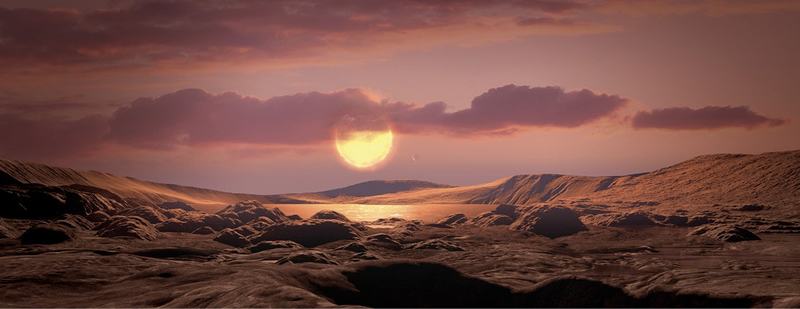 This artist’s concept shows the newly discovered exoplanet Kepler-1649c orbiting in the habitable zone of its host red dwarf star. It is the closest to Earth in size and temperature found yet in Kepler’s data.
This artist’s concept shows the newly discovered exoplanet Kepler-1649c orbiting in the habitable zone of its host red dwarf star. It is the closest to Earth in size and temperature found yet in Kepler’s data.
Future telescopes
The effectiveness of a telescope at searching for biosignatures is determined by its size, wavelength range, resolution, mission lifetime, and ability to filter out unwanted background light. These factors have given rise to a highly diverse array of telescope designs, each with their own merits. The 2020s will witness the launch of both JWST and RST (formerly WFIRST), two space-based telescopes whose primary missions are not the study of exoplanets, but which should be able to study the atmospheres of a few of the closest, clearest Earth-like worlds. They will not be able to detect oxygen but could search for signs of chemical disequilibrium in methane and carbon dioxide.
During this decade several gigantic ground-based telescopes will be built: the Giant Magellan Telescope (GMT), the Thirty Meter Telescope (TMT) and the Extremely Large Telescope (ELT), all larger than 25 metres diameter, will be able to characterise even oxygen in several Earth-like worlds. However, atmospheric noise is a limiting factor for these telescopes, which will limit their search to stars that are redder and smaller than the Sun.
From Earth’s example, it’s clear that not all biosignatures signal the same information
Several dedicated planet-hunting space telescopes have been proposed for launch in the 2030s: HabEx, LUVOIR and Origins Space Telescope (OST) will be able to detect not just chemical equilibrium and oxygen, but test for multicellularity and technosignatures as well. OST and HabEx would be able to characterise one to two dozen Earth-like planets, depending on their final designs, and LUVOIR could characterise as many as 100.
Beyond that, even more radical designs promise to deliver even more Earth-like exoplanets. Several proposals aim to harness the power of interferometry, which couples a network of telescopes together to effectively create a potentially enormous lens. The ExoLife Finder (ELF) would be ground based and could yield 100 Earth-like planets. OWL-MOON proposes to turn a crater on the Moon into a gigantic interferometer, yielding 1,000 or more. The Hypertelescope would be a network of satellites that could potentially yield 50,000.
In Figure 2, we illustrate the accuracy of the measurements that could be achieved with two potential future telescopes. Here, the occurrence rates are strictly defined as the fraction of planets that achieve each stage of life, given that the previous has been achieved. In these plots, the occurrence rates, denoted by f, are optimistically taken to be 0.5, 0.4, 0.7 and 0.6, respectively. The uncertainties come from the small sample sizes of each measurement and can be seen to grow with each successive stage. The mission sample sizes are taken to be 500 for LUVOIR and 3,000 for OWL-MOON. While the measurements from LUVOIR would be more than worthwhile, the precision of OWL-MOON will allow for a much more accurate determination of how often each stage of life occurs.
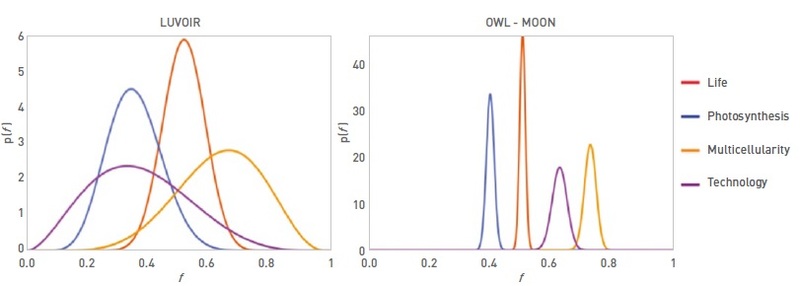 Figure 2. Measurement of the occurrence rates for the four stages of life for two potential future telescopes, LUVOIR and OWL-MOON. The uncertainties grow with each successive stage but remain narrow for OWL-MOON.
Figure 2. Measurement of the occurrence rates for the four stages of life for two potential future telescopes, LUVOIR and OWL-MOON. The uncertainties grow with each successive stage but remain narrow for OWL-MOON.
Nobody knows what the first telescopes capable of detecting life on other planets are going to find. Determining how common life is throughout the universe is a key scientific goal of our era and will have radical implications for many aspects of society. Any tool to more effectively facilitate this transition will certainly serve us well when the time comes. Information gain is a simple, transparent, (relatively) unbiased method to compare the diverse upcoming search strategies and technologies. It will help us ask the right questions and find the answers to those questions most effectively. We find that numbers count. Only by optimising the exoplanet yield to a level that allows sufficient information gain can we hope to progress towards addressing one of the most important questions in science: are we alone?
About the authors
McCullen Sandora earned a PhD in theoretical physics from the University of California Davis in 2014. He has held academic research positions in cosmology at the University of Southern Denmark, Tufts University, Massachusetts, and the University of Pennsylvania. He is currently a researcher in the health sciences division of Elsevier and a member of the Sellers Exoplanet Environments Collaboration at NASA Goddard, where he pursues connections between cosmology, biology, and planetary science.
Joseph Silk is a research professor at Johns Hopkins University in Baltimore, USA, and is also at the Institut d’Astrophysique, Paris, and the Beecroft Institute for Particle Astrophysics and Cosmology at the University of Oxford. Most of his scientific research is related to cosmology and particle astrophysics. He has also published several popular books on cosmology.





